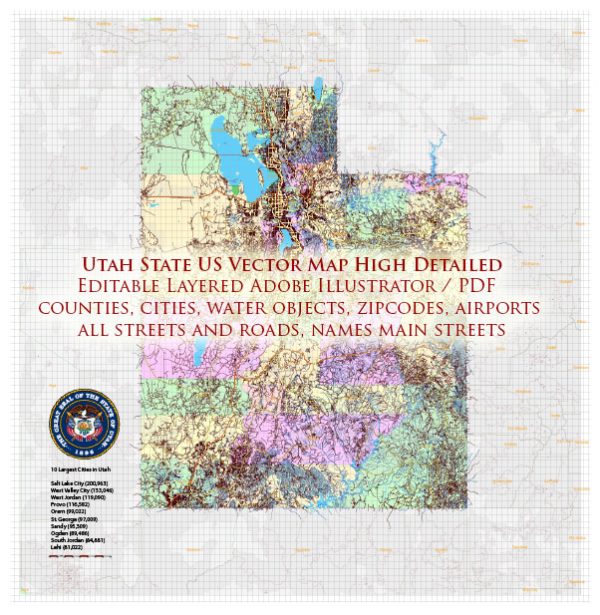Utah, located in the western United States, has a rich history and a diverse transportation infrastructure that has evolved over the years.
Vectormap.Net provide you with the most accurate and up-to-date vector maps in Adobe Illustrator, PDF and other formats, designed for editing and printing. Please read the vector map descriptions carefully.
Let’s take a closer look at both aspects:
History:
Native American Presence:
- Utah’s history dates back thousands of years, with evidence of Native American cultures such as the Ancestral Puebloans, Fremont, and Ute tribes.
- The region became a crossroads for trade and cultural exchange among various Native American groups.
Mormon Pioneers:
- In 1847, a group of Mormon pioneers led by Brigham Young arrived in the Salt Lake Valley, seeking religious freedom. This event marked the beginning of Utah’s pioneer era.
- The Mormons established a prosperous community, building the city of Salt Lake City and developing irrigation systems to cultivate the arid land.
Statehood and Growth:
- Utah became a U.S. territory in 1850 and achieved statehood in 1896.
- The state’s economy grew with the discovery of valuable resources like silver, lead, and copper. Agriculture also played a significant role in Utah’s development.
World War II and Industrialization:
- The state experienced economic growth during World War II, with the development of military facilities and industries.
- The post-war period saw further industrialization, and Utah became known for its aerospace and defense sectors.
Modern Economy and Technology:
- In recent decades, Utah’s economy has diversified, with significant contributions from technology, finance, and outdoor recreation industries.
- Salt Lake City, the capital, has emerged as a hub for technology companies, earning the nickname “Silicon Slopes.”
Transportation Infrastructure:
Early Transportation:
- In the pioneer era, transportation relied on horse-drawn wagons, stagecoaches, and the Transcontinental Railroad, which reached Utah in 1869.
- Waterways such as the Great Salt Lake and the Colorado River were essential for early transportation and trade.
Railroads:
- Railroads played a crucial role in Utah’s economic development. The Transcontinental Railroad, linking the East and West coasts, had a major junction in Ogden.
- Today, Utah has an extensive rail network, supporting freight transportation.
Highways and Roads:
- The state has a well-developed network of highways and roads, connecting urban centers and rural areas.
- Interstate 15 (I-15) is a major north-south corridor running through the state, connecting Salt Lake City with cities like Provo and St. George.
Airports:
- Salt Lake City International Airport is the primary gateway to the state, serving as a major hub for domestic and international flights.
- Regional airports, such as those in Provo and St. George, contribute to air transportation within the state.
Public Transportation:
- Utah Transit Authority (UTA) operates buses, commuter trains, and light rail services in the Salt Lake City metropolitan area, providing public transportation options.
- The state has invested in expanding public transit to address growing population needs.
Future Developments:
- Utah continues to invest in transportation infrastructure to accommodate population growth and economic expansion.
- Projects include highway expansions, public transit enhancements, and improvements to address the state’s unique geographical challenges.
In summary, Utah’s history is marked by the pioneering spirit of early settlers and subsequent economic diversification. Its transportation infrastructure has evolved from pioneer trails to a modern network of highways, railroads, airports, and public transit systems.


 Author: Kirill Shrayber, Ph.D.
Author: Kirill Shrayber, Ph.D.